Contaminated water is your community at risk? A recent study by the U.S. Geological Survey (USGS) has unearthed alarming statistics:
An Estimated 45% of the Nation’s Tap Water Contains One or More types of per- and polyfluorinated alkyl substances (PFAS).
These chemicals, often referred to as “forever chemicals” due to their slow degradation, are the hidden culprits behind a mounting health and environmental concern.
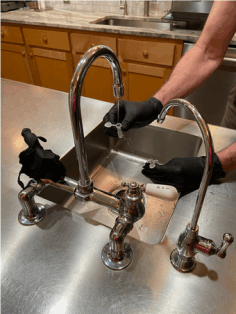
PFAS and the Widespread Concerns on Health Risks and Contaminated Water
PFAS, with over 12,000 known types, are synthetic compounds used in various everyday applications, ranging from fast-food packaging to non-stick cookware and firefighting foams. While the U.S. Environmental Protection Agency (EPA) is still researching the long-term health effects of PFAS exposure, high concentrations have already raised concerns about adverse health risks. Their widespread prevalence, environmental persistence, and health implications make PFAS a unique water-quality concern.
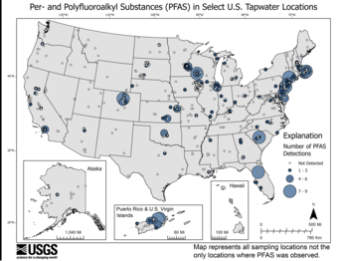
PFAS in America’s Tap Water: Is Your Community at Risk?
What sets the recent USGS research apart is that it’s the first comprehensive study to assess PFAS contamination in both private and government-regulated public water supplies across the entire nation. The study’s results provide essential insights into the magnitude of the issue, empowering the public to understand the risks associated with their water sources and informing critical policy and management decisions regarding testing and treatment options.
The responsibility for ensuring safe water supply rests on multiple shoulders. The EPA oversees public water supplies, while homeowners bear the burden of maintaining, testing, and treating private wells. To confirm the presence of PFAS contaminants in wells, testing is essential, and local and state officials can offer guidance to those seeking to address this concern. For additional information on PFAS regulations, the EPA’s website offers valuable resources.
The USGS study, which tested for 32 individual PFAS compounds, revealed some disconcerting findings. The most frequently detected PFAS compounds included PFBS, PFHxS, and PFOA. Even more alarming, interim health advisories set by the EPA for PFOS and PFOA in 2022 were exceeded in every sample where these compounds were detected.
The exposure to PFAS was not uniform across the nation. USGS scientists collected tap water samples from 716 locations, categorized as low, medium, and high human-impacted areas. Urban areas and locations with reported PFAS sources, such as industrial or waste sites, exhibited the highest levels of exposure. This includes regions like the Great Plains, Great Lakes, Eastern Seaboard, and Central/Southern California. The study supports previous research, indicating that urban populations face a higher likelihood of PFAS exposure.
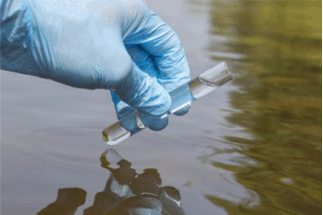
3M’s $10.3 Billion Settlement Highlights Urgent Need for PFAS Contamination Solutions
Addressing PFAS contaminated water is a formidable task, but there are viable solutions and strategies available to mitigate its presence and safeguard our communities. Notably, 3M, one of the 25 major chemical companies, recently settled a lawsuit with the District Attorney of Washington DC for a substantial $10.3 billion. This settlement underscores the gravity of PFAS contamination and the responsibility of corporations in addressing its consequences.
Here are some key approaches and technologies in tackling PFAS contaminated water:
1.) Activated Carbon Filtration: Utilizing activated carbon filters to adsorb PFAS compounds from water is a widely used method. These filters efficiently capture PFAS, although they require periodic replacement or regeneration as they become saturated.
2.) Ion Exchange Resins: Water treatment plants often employ ion exchange resins to remove PFAS by replacing harmful ions with less harmful ones, effectively reducing PFAS levels.
3.) Reverse Osmosis: Employing reverse osmosis systems equipped with semipermeable membranes can effectively filter out PFAS and various contaminants from water.
4.) Advanced Oxidation Processes (AOPs): AOPs employ chemicals or energy sources like UV light or ozone to degrade and break down PFAS compounds. Though effective, this method can be costly and produce byproducts needing treatment.
5.) Bioremediation: Ongoing research explores the use of bacteria and microorganisms to biodegrade PFAS in water, although it is currently in the experimental phase and not yet widely adopted.
6.) Source Removal: Identifying and addressing the sources of PFAS contamination, such as industrial sites or landfills, is crucial in preventing further contamination and remains one of the most effective strategies.
7.) Legislation and Regulation: Governments are introducing regulations and guidelines to limit PFAS use and release across various industries, promoting responsible practices.
8.) Monitoring and Testing: Regular monitoring and testing of water sources are essential for early PFAS detection, enabling swift action to protect public health.
It’s important to recognize that addressing PFAS contamination demands significant resources and technical expertise. There is no one-size-fits-all solution, as treatment methods depend on various factors, including the types and concentrations of PFAS present. Coordinated efforts among government agencies, water utilities, and environmental experts are crucial.
Ultimately, the overarching goal is to minimize PFAS exposure, safeguard public health, and prevent further contamination of our vital water sources. The recent settlement by 3M serves as a stark reminder of the urgency and responsibility in addressing the challenges posed by PFAS contamination. Do your own research on contaminated water to find out if your community is at risk.


Plantsol Essential Oil Cleaner Concentrate w/spray bottle
$27.99
100% natural with family safe ingredients. Amazing for the kitchen, bathroom, countertops, floors and pet items.
All Natural & Plant-based Ingredients
Cleans, degreases, deodorizes, removes stains & aromatherapy benefits
Makes 8 Quarts = Less than $3.49 each quart
Size: 32oz Scent: Mixed Essential Oil
About the Author

Bonnie Pellerin
Microbiologist
Bonnie Pellerin, a Biotechnology graduate and seasoned microbiologist, specializes in identifying bacteria and mold. Alongside her formulating chemist husband, she co-founded EarthSential, driven by their shared mission to create a safe haven free from harsh chemicals for their children and others. Bonnie’s expertise and dedication continue to shape the field of biotechnology and environmental safety.
Deceptive
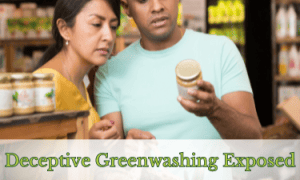
Greenwashing Exposed
by Bonnie Pellerin Ι Aug 5, 2023 Ι 5 Min Read
Agroforestry
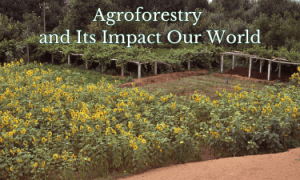
and Its Impact Our World
by Bonnie Pellerin Ι Aug 6, 2023 Ι 5 Min Read
Banning

Single-Use Plastic Bottles
by Bonnie Pellerin Ι Sept 25, 2023 Ι 5 Min Read
Starting a

Compost Bin
by Bonnie Pellerin Ι Sept 25, 2023 Ι 5 Min Read
The Power of Nature

How Peppermint, Clove and Thyme Work Together to Repel Rodents
by Minus Bite Ι May 3, 2023
Get the EarthSential Newsletter
Good deals, great advice & essentially necessary.



